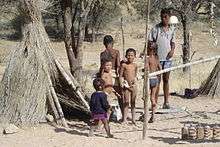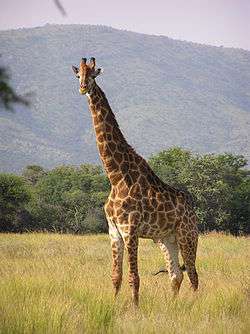Central Kalahari Game Reserve
Central Kalahari Game Reserve is an extensive national park in the Kalahari desert of Botswana. Established in 1961 it covers an area of 52,800 square kilometres (20,400 sq mi) (about twice the size of Massachusetts, and 1/11 of Botswana's total land area) making it the second largest game reserve in the world.[1]
The park contains wildlife such as South African giraffe, bush elephant, white rhino, cape buffalo, spotted hyena, brown hyena, honey badger, meerkat, yellow mongoose, warthog, South African cheetah, caracal, Cape wild dog, black-backed jackal, bat-eared fox, cape fox, African leopard, Kalahari lion, blue wildebeest, plains zebra, common eland, sable antelope, gemsbok, springbok, steenbok, impala, greater kudu, aardvark, cape ground squirrel, cape hare, cape porcupine, chacma baboon, red hartebeest and ostrich. The land is mostly flat, and gently undulating covered with bush and grasses covering the sand dunes, and areas of larger trees. Many of the river valleys are fossilized with salt pans. Four fossilized rivers meander through the reserve including Deception Valley which began to form around 16,000 years ago.[2]
The Bushmen, or San, have inhabited the lands for thousands of years since they roamed the area as nomadic hunters.[3] However, since the mid-1990s the Botswana government has tried to relocate the Bushmen from the reserve, claiming they were a drain on financial resources despite revenues from tourism. In 1997, three quarters of the entire San population were relocated from the reserve, and in October 2005 the government had resumed the forced relocation into resettlement camps outside of the park leaving only about 250 permanent occupiers.[2] In 2006 a Botswana court proclaimed the eviction illegal and affirmed the Bushmen's right to return to living in the reserve. However, as of 2015 most Bushmen are blocked from access to their traditional lands in the reserve. A nationwide ban on hunting made it illegal for the Bushmen to practice their traditional hunter-gatherer lifestyle, despite allowing private game ranches to provide hunting opportunities for tourists.[4]
In 2014 a diamond mine operated by Gem Diamonds opened in the southeast portion of the reserve. The company estimated that the mine could yield $4.9 billion worth of diamonds. The Rapaport Diamond Report, a diamond-industry pricing guide, stated, "Ghaghoo's launch was not without controversy [...] given its location on the ancestral land of the Bushmen".[5]
A huge bush fire in and around the park in the middle of September 2008 burnt around 80 percent of the reserve. The origin of the fire remains unknown.[6][7]
Gallery
 A female ant-eating chat
A female ant-eating chat Children of the Kalahari
Children of the Kalahari
References
- ↑ Central Kalahari Game Reserve - Attractions - Tourism of Botswana
- 1 2 "Go2Africa.com". Go2Africa.com. Retrieved 2013-09-24.
- ↑ Central Kalahari Game Reserve - Botswana Archived October 19, 2007, at the Wayback Machine.
- ↑ Dixon, Robyn (28 February 2015). "In Botswana reserve, Bushmen still being deprived of rights". Los Angeles Times.
- ↑ Miller, Jeff (5 September 2014). "Gem Diamonds Opens Its Underground Ghaghoo Mine". Rapaport | Diamonds.Net.
- ↑ "Report and satellite image from NASA". Earthobservatory.nasa.gov. 2008-08-29. Retrieved 2013-09-24.
- ↑ Michon Scott; Rebecca Lindsey (26 September 2008). "Huge Bushfire in the Kalahari". NASA Earth Observatory. Retrieved 3 May 2011.
External links
| Wikimedia Commons has media related to Kalahari. |
Coordinates: 21°53′22″S 23°45′23″E / 21.8895°S 23.7565°E
